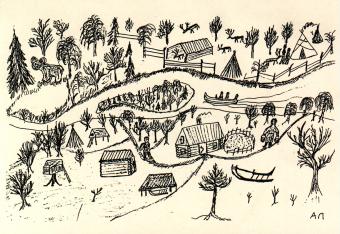 |
Uhri - Elokuva Metsästä
Das Opfer -
ein Film über einen Wald
The Sacrifice
- A Film about A Forest
M.Lehmuskallio,
A.Lapsui
Finnland 1998
Produktion:
Jörn Donner Productions, The Finnish Film Foundation, AVEK, YLE/TV2,
SVT/Lulea, Media II Programm
Weltvertrieb: Jörn Donner Productions Pohjoisranta 12, 00170 Helsinki,
Finnland
Tel. (358-9) 135 60 60, Fax 135 7568
Ton:
Anastasia Lapsui, Marja Leena Tuuri, Antero Honkanen.
Musik: David Darling, Antero Honkanen, Meredith Monk, Sainkho Namtchylak
Sprachen: Selkup, Finnisch
Format: 35mm , 1:1.66, Farbe Länge: 59 Minuten, 24 B/sek.
|
| Im
westlichen Sibirien lebt das Volk der Selkups. Sie sind Fischer und Jäger.
Die meisten der fünftausend übriggebliebenen Selkups sind in
die paar Dörfer ihres Gebiets gezogen. Sie finden kaum Arbeit, und
so ernähren sie sich von dem, was der Wald ihnen gibt. Der Film zeigt
einen Ausschnitt aus dem Leben der Familie von Juri Michailowitsch Kalin.
Sie gehört zu den tausend Nord-Selkups, die das Waldgebiet in der
Nähe des Flusses Tas als Nomaden bevölkert. Sie besitzen keine
Rentierherden, sondern benutzen sie lediglich als Zugtiere für ihre
Schlitten. Seit vierhundert Jahren leben die Selkups in der Nähe
der russischen Handelsstraßen. Zuerst kamen Pelzhändler, später
Mannschaften, die nach Öl oder Gas suchten. Doch der Lebensstil der
Selkups ist im Wesentlichen unverändert geblieben. Der Wald und die
Selkups bilden eine Einheit. “Immer wieder schauen der Finne und
die Nenzin dem Jäger und Fallensteller ins Gesicht und beobachten
ihn dabei, wie er in den Wald hineinhorcht. Und so wie die Selkupen sich
an ihren heiligen Plätzen für all das bedanken, was der Wald
ihnen ‘gab’, so ist auch dieser Film über sie und ihren
Wald in gewisser Weise das Abtragen einer Dankesschuld: eine Gegen-‘Gabe’
also, deren einzelne Teile ’Platzwechsel’, ’Zivilisation’,
‘Freizeit’, ‘Eine Tragödie’ usw. heißen
und von Liedern zusammengehalten werden.” Helmut Höge
|
The Selkup people live in
western Siberia.They are fishermen and hunters. Most of the remaining
Selkups have moved to the few villages of their territory. Work is hardly
available, so people still live off the forest. This film documents
the life of Juri Mikhailovitch Kalin and his family. They belong to
the 5,000 Northern Selkups who live in the forest close to the River
Tas. They lead a nomadic life. They are not reindeer herders, but use
reindeer to pull their sleds. In winter, Juri Mikhailovitch moves home
every few weeks. In the early winter their prey is elk, then sable.
For 400 years the Selkups have lived on the Russian trade routes. First
came fur buyers, later people searching for gas and oil. The basic elements
of Selkup life haven’t changed much. The forest and the Selkups
are one and the same. It takes time ‘to get in’ – and
it is an invisible process. It is just as difficult for the filmmakers.
Even when he knows, like Markku Lehmuskallio: ‘When I film a moment
I feel I am capturing something invisible’. The Finnish and the
Nenzen filmmaker, both hunting for sounds and images, assure a ‘continuity
spanning the generations’ and a ‘continuation of tradition’.
Again and again they observe the faces of the hunter and the trapper,
watch how they look into the forest, how they listen to the forest.
Just as the Selkup thank the forest at their shrines for all the things
it ‘gave’ to them such as elks, capercaillie, bears, sables,
pike and other fish, also berries and fire wood, this film is also a
kind of ‘thank you’: a gift in return made up of sections
entitled ‘Change of place’, ‘Civilization’, ‘Leisure
time’, ‘A tragedy’ etc. They are held together with songs.”
Helmut Höge
|
Biofilmographie
/ Biofilmography
Markku Lehmuskallio wurde 1938 geboren und arbeitete von
1963 bis 1969 als Förster. Sein Leben veränderte sich grundlegend,
als er bei einem Feuer alles verlor. Er war immer schon ein begeisterter
Photograph gewesen und kaufte sich schließlich auf Anraten eines Freundes
eine 16mm-Kamera, mit der er Auftragsfilme für Firmen und Dokumentarfilme
über die Natur für das finnische Fernsehen drehte. Lehmuskallio
hatte bereits diverse Filme gedreht, als er Interesse am Medium Film als
Ausdrucksform entwickelte. Eine große Quelle der Inspiration sind für
ihn die Filme von Robert Bresson.
Markku Lehmuskallio was born in 1938 and became a forester
in 1963, after which he worked for the timber industry until 1969. His
life changed completely, when he lost everything in a fire. He had always
been a keen photographer, but encouraged by a friend, he acquired a 16mm
film camera and began to make commissioned films for companies and nature
documentaries for Finnish television. Lehmuskallio had already completed
several productions, when he developed an interest for film as a form
of expression. He has drawn a great deal of inspiration from the works
of Robert Bresson.
Filme
1974: Sounds of the Northern Forest (Kurzfilm). 1975: The Man with Two
Faces (Kurzfilm). 1976: Maestro and Nature (Kurzfilm). 1980: Korpinpolska
- The Raven's Dance (Spielfilm). 1982: Skierri - Land of the Dwarf Birch
(Spielfilm). 1985: Sininen imettäjä - The Blue Mammy (Spielfilm).
1988: Inuksuk (Spielfilm). 1992: I Am (Dokumentarfilm). Filme zusammen
mit Anastasia Lapsui 1993: In Reindeer Shape Across the Sky (Dokumentarfilm).
1994: Paradise Lost (Dokumentarfilm). 1995: The Farewell Chronicle (Dokumentarfilm).
1997: Anna (Dokumentarfilm). 1998: Uhri – elokuva metsästä (Das
Opfer - Ein Film über den Wald). 1999: Seven Letters from the Tundra. |